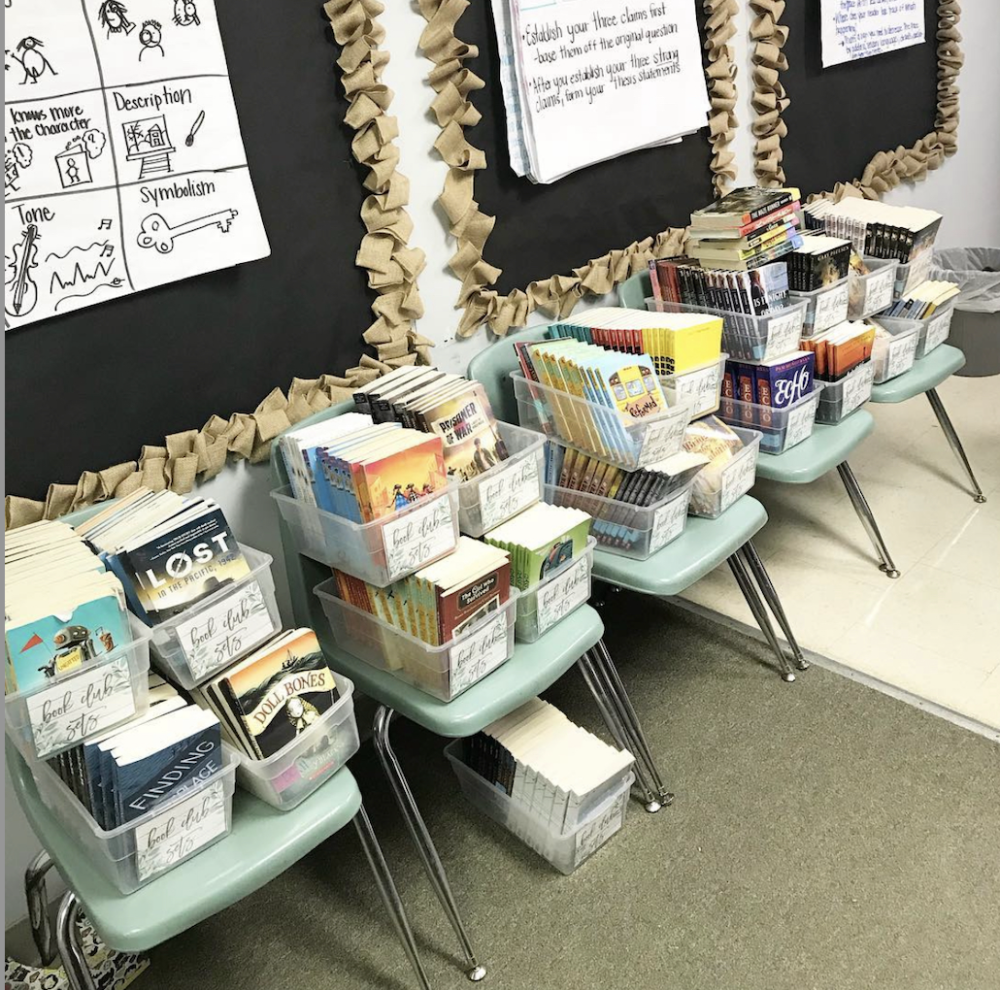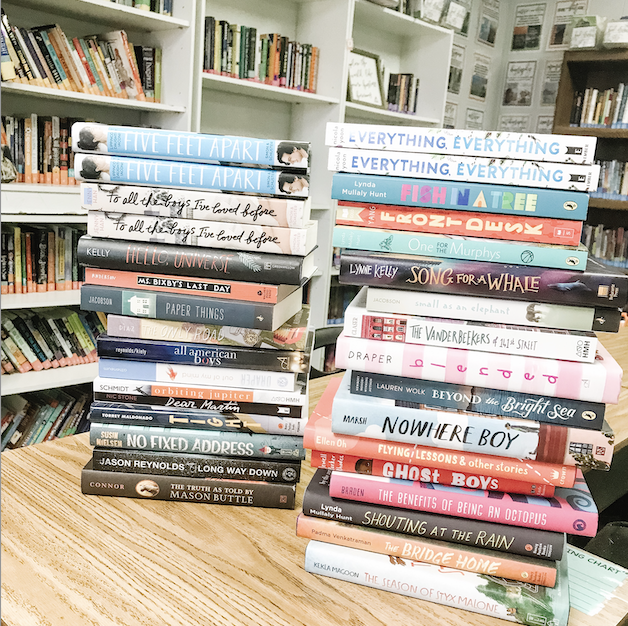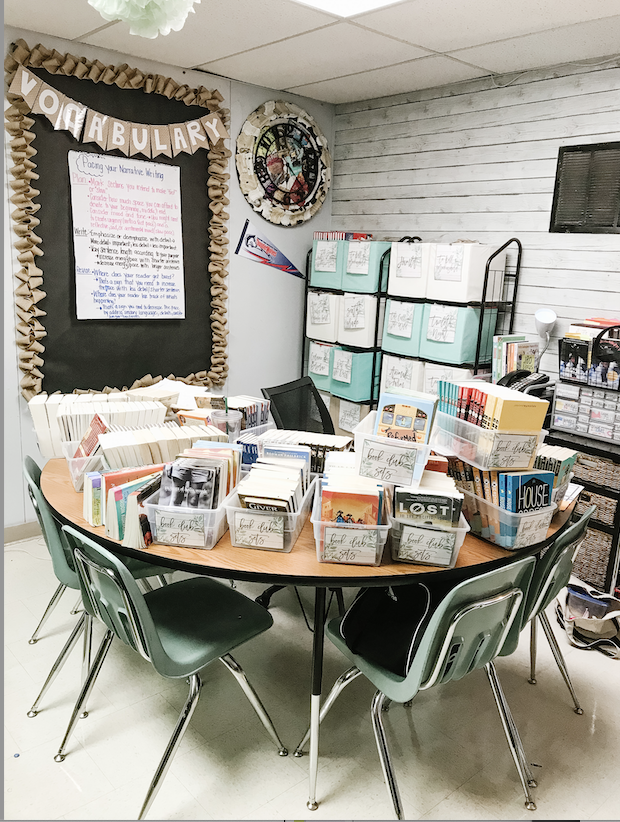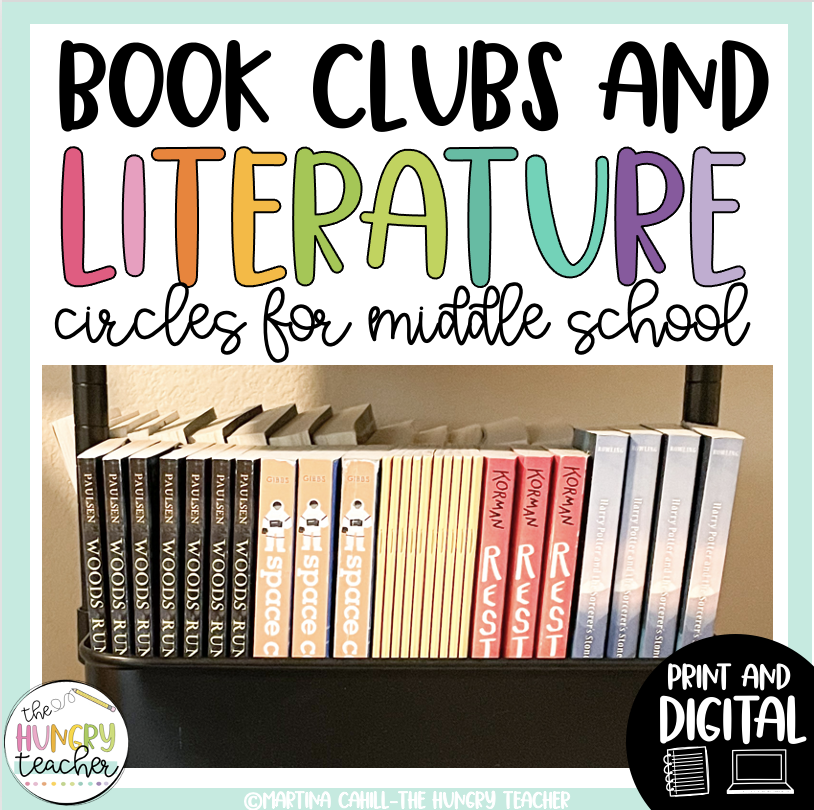hey friend!
I'm Martina.
I provide practical, time-saving strategies that actually work—so you can engage your students, teach effectively, and reclaim your time from the exhausting planning-grading cycle.
Browse Our ELA Resources
Book Clubs in the Middle School ELA Classroom
I recently posted about book clubs in my classroom and have gotten many questions about how I run them on both posts.
I am going to try and answer them all here.
First and foremost, I try to make Book Clubs as simple as possible. I used to be MUCH more involved in the book clubs when I taught fifth grade, but I only had 24 students then, and I had them all day long… and well, they were in fifth grade. I used the book clubs to support them and teach them as readers.
Now that I have progressed to seventh and eighth-grade English, my procedures and management have changed.
I will keep it as real as possible because when I first started looking into implementing book clubs at this age, I wanted the absolute truth.
Here is what I have learned, and here are the facts.

PUTTING STUDENTS INTO GROUPS

I don’t do it by reading levels.
GASP. I know, but honestly, that ruins the whole point of book clubs. I do it by 90% interest. I briefly show students ALL the options, my opinion of the book, who tends to like it, its genre, and subject. Then they can walk around and look at them all. Then they have to give me their top 5 choices for book club books. It used to be 3, but now with so many students, I have to go to the top five, but I also have A LOT more book club choices.
I *try* really hard to put them with their friends. 90% of the time, this works in my favor because friends have the same interests and hold each other accountable… the other 10% are a complete disaster (but I can usually predict that).
Sometimes I have kids I know will make a book club difficult no matter which one I put them in. Not being mean, promise. Some kids just struggle with book clubs. I tend to put those 2-3 students in a book club together. Sometimes they set out to prove themselves and have great success, or it’s a complete disaster. I always have at least one group like this, but I would rather it be one group than 3 or 4 that are a total disaster, so I just prepare myself and check in with them A LOT. If one or some end up proving themselves, they go to different groups next round, which is really what I want anyway.
After students have given me their top five choices, I get to work making the groups. I almost always can give them one of their top two choices, but sometimes (due to not enough books, too many people in groups, or dynamics) I do have to give them their third, fourth or fifth choice. I also gave my 8th graders priority.
Again, I don’t pay too much attention to reading levels, but I do pay attention to stamina. If I know a student struggles to finish books, if he/she has Divergent as an option, but also something like A Long Walk to Water (highly engaging, great book, but also short) then I will give them the shorter book, especially for the first time to set them up for success.
THE GOOD, THE BAD, THE UGLY
Wait to do book clubs. My mentor teacher told me to wait at least six weeks into school. SHE IS MORE THAN RIGHT. When I was an elementary teacher, it was hard for me to wait that long because I loved them, and management was simple.
In middle school, sometimes it hasn’t been until the second semester, simply because I’ve had to wait until a point I thought they could handle it and a point where I felt I could manage it.
Some kids will NEVER read and will NEVER do their book club work or homework. Or they will pretend and make up the reading and/or homework.
I wish I could tell you that 100% of my students do their book club homework, but it’s not reality. I REALLY do not want to give them quizzes, or comprehension activities, or just another thing for them to do. So I don’t. I want book clubs to be fun, and to provoke conversations, and give kids common things and interests to talk about.
I make the homework simple and designed to help guide their discussions, and 95% of the students do just that. I also work hard to get the other 5% to appreciate the process and idea. Some come around, and some never do. I don’t give up on them, but I just know it happens.
Sometimes, kids pick books they don’t like and want to quit. This is a tough one. If the whole group is on board after the first week, I will allow them to abandon and come to a new agreement for their book. If it’s just one student, I try to have a discussion with them and see what’s best for them and their group. Sometimes they abandon, move to another group, and have to play catch-up. Sometimes they just have to suck it up. Again, it doesn’t happen often, but there are always a few.


STUDENTS READING AHEAD
Some people read ahead. Let them. As a class, always make strict rules about no “SPOILERS.” If you read ahead, you need to review where your group is so you don’t reveal information later in the book. They must also ensure they only do their “homework” for that week’s reading.
Who doesn’t want to read ahead when a book gets good? Four weeks is a long time for genuine readers. Often these kids end up in groups together, end up reading the whole book in a week (I usually tell them not to worry about the homework and just have discussions), and will devour 3-4 books during the span of 4 weeks. UMMMM….. I call that a success. That’s the real goal, so I 100% let the book clubs evolve as needed.
GETTING ALL YOUR BOOKS

I probably get this question more than anything. Honestly, I buy them all. I have been buying the sets for the last 5 years, but it’s more than worth it. I built up a solid collection for grades 4-6, but then switched to 7th and 8th and have started to have to buy other sets to keep up with their interests and needs.
I could sit here and tell you that I scope out the best books and the highest quality of literature, but I have a couple problems with that thinking.
First of all, I’m not sure who gets to decide what “quality” literature is, except the reader… so I don’t make the decision. Currently, my new school has a big focus on “the classics,” so we’re getting plenty of that. Third, I just buy what I can get sets of.
Any time books go on sale for $1-$3 on Scholastic, I buy 5-6 copies. Over time, you have a pretty good collection of book club sets. Now that I have a solid collection, I focus on getting specific genres and interests to meet my current students’ wants and higher reading levels, and now I’ve focused more on getting some good non-fiction sets.
Also, hate to break it to you, but you REALLY have to read the book club books your students read. I have read 80-90% of my sets, and if a club picks a new book, I make sure to read as they read. It’s not always easy, but it’s kind of necessary because kids know when you haven’t read the book.
*The exception is when you have a book club form naturally, and you know the kids are reading (again, this is the real goal of book clubs, and they don’t need you too much anymore). Sometimes groups bring in their own books and do that for the club. 99% of the time, those self-motivated groups, do it all without me, and that’s the best thing ever!
BOOK CLUB RESOURCES
I almost always start our really structured and then lay off a bit, or we continue with a lot of structure as I see fit.
We use A LOT of interactive notebook pages in my class, but we used traditional roles in this resource. I used my literature circles resource in sixth, seventh, and eighth grade ELA because I wanted something that wasn’t as structured but pushed their thinking.
RUNNING BOOK CLUBS?
This changes constantly.
When I taught fifth grade, they decided how much they would read each week. They each had to come to the group with three questions to ask, we would meet (me included, to help run the groups and make them think deeply about the books), discuss the books and our questions, and then we would do it all over again.
In seventh and eighth grade, my first years I wanted to have more structure, because I can’t meet with all my groups every week simply because of time constraints. Also, they’re in seventh and eighth grade, so I would like them to be able to read the books they want, have conversations with each other, and see how book clubs really should be.
I also made sure to have students map out how long they had to read the books. For seventh and eighth graders, they had four weeks, and they just did the math themselves. They just divided the book’s number of pages by four so they could determine how many pages they had to read each week.
I also tell them beforehand so students who think they don’t “read fast” know what is expected of them.
Then they are responsible for one “job” each week. I usually give them time for a packet with 4-5 pages of jobs, and they have to do one week’s reading and one page of the packet.
For example, a group is reading Al Capone Does My Shirts and had to read 60 pages during week one. Student One would be reading those 60 pages and be responsible for the “Discussion Director” for only those 60 pages, and Student Two would read the same 60 pages and be in the “Plot Profiler” for those 60 pages. The following week, they switch jobs for pages 61-120.
LITERATURE CIRCLE EXAMPLE
Here’s a better example of group break-down.
Week One: Read pages 1-60
Week Two: Read page 61-118
Week Three: Read pages 119-183
Week Four: 184-237 (finish book)
Week One:
Mariah: Discussion Director
Richie: Plot Profiler
Mackenzie: Illustrator
Nico: Literary Luminary
Week Two:
Mariah: Plot Profiler
Richie: Illustrator
Mackenzie: Literary Luminary
Nico: Discussion Director
Week Three:
Mariah: Literary Luminary
Richie: Discussion Director
Mackenzie: Plot Profiler
Nico: Illustrator
Week Four:
Mariah: Illustrator
Richie: Literary Luminary
Mackenzie: Discussion Director
Nico: Plot Profiler
GRADING BOOK CLUBS
This is a tough one because I don’t want to make reading something they hate, so I try to make it all about them and ensure they don’t let their book club down.
By making book clubs a big deal and selling their value and purpose of them (to enjoy books and have conversations about books with people who have similar interests), they kind of do the whole disappointed in their peers and classmates thing for me.
I always have a group or a few who band together and act like they don’t care that none of them do the work and/or reading, but the rest of the class tends to think they’re lame and don’t join in on their bad attitudes. Just keeping it real. It does happen, but when they all come unprepared, I just say, “That’s a bummer. Hope you guys do it next week so you can have a book discussion then.” Yes, even eighth graders.
But, when I use a traditional literature circle format, I do assign grades for the work simply because I’m a realist.


STUDENT RESPONSIBILITIES
Students are responsible for reading 1/4 of the week and one page of their packet. I make it 25 points each week… for 100 points.
The packet gets turned in at the end of the four weeks and becomes another 100 points. That way, if they get behind, miss a page, or have a bad week, they can go back and complete the pages and earn 100 points on the packet.
They only get the 25 points on the day books clubs meet (it’s automatically a zero if they come unprepared, with no room to make it up, but they can and should do the reading and homework page later for when they turn in the packet).
I do this so they complete the reading later and don’t get further behind and because I think it shows their peers something if they mess up but are willing to do the work to be back in the club.
If they come unprepared more than once, they are “kicked out” and must finish the novel independently and write an essay. I didn’t have a single student miss work more than once because of this.
I just walk around when they meet (all clubs meet on Mondays), and while they’re discussing, give them 25 points or a 0.
After they’re done meeting, I talk to my zeros and what they need to do for next week.
Want more help implementing book clubs in your classroom. I’ve taken everything I’ve learned over the years and created what has become my most popular workshop: Book Clubs in a Box.
Want a sneak peek at teaching The Hungry Teacher way—with support, structure, and strategy?
When you join the waitlist for The Hungry Teacher’s Hub membership, you get three free classroom-ready resources: a theme unit, an expository writing unit, and a grammar unit introducing mentor sentences. Plus, you’ll get immediate access to a selection of exclusives from the Hub, including editable sub plans, pacing guides, and more.
No strings attached. Just resources you can use right now—and a heads-up when the Hub opens.
3 Free Middle School ELA Units—yours to keep!
JOIN THE WAITLIST + A FREE GIFT
Where to next, line leader?
Welcome to The Hungry Teacher! We create resources that are easy to use, practical, and get results. Teach with confidence—and make it home before dinner.
xo, the hungry teacher



Great post, thank you for sharing! Another question, and my apologies if you have answered this in a previous post…you mentioned you do book clubs for about 4 weeks. How do you structure your classes in terms of the book club structure (reading, discussing, etc.) Do you give them time to read in class or is it always done at home? Also, are you also responsible for teaching writing, and if so, how do you incorporate writing into book clubs?
Of course! So we aways read the last 10-15 minutes of class each day. They can use that time to read or they can do it home. Most do a both! On Mondays, that 15 minutes is used for book clubs to meet and discuss and for me to come around and grade. The first week, I allow for more like 25-30 minutes to get them settled. I do also teach writing, but right now we are doing poetry, so I have been doing a mini-lesson on poetry, practice with writing the poems, then we do the silent reading. Next week we will work on writing during the first 40 minutes and/or I will do mini-lessons as they work on their poetry anthologies. Then we will still have the last 10-15 to read or meet. It's not perfect, but it works. Lastly, the book club packets do ask them to write a lot. some write more than others, but it does make them think and write. Next round of book clubs I want them to do a literary analysis on their book club books, but that just didn't work this go around! Hope that helps!
This post was so helpful! I teach 5th grade departmentalized ELA, so I feel like it's more similar to middle school than self-contained elementary classrooms. I love your ideas about giving them a time constraint to finish a book (most of mine get the books read in a good amount of time, but I definitely have some straggler groups) and buying the $1 books from Scholastic to build your collection. Thanks for posting this!
Thank you for sharing!
One thing that I do is to have 5 meeting dates and when the students get into their groups, their first task is to split up the book into 5 sections. Some groups choose to have the first few meetings with longer readings and then shorter at the end and others choose the opposite. I love it this way because no one can complain how much or how little they are reading because they chose it!
I also make the last meeting date with no roles so with 4 roles, there needs to be 5 meeting dates. That way, they have the last week to get their sheets organized and ready to hand it.
🙂
Love this post! Thanks!
I am new to a 5th/6th grade reading block schedule. I am historically a 5th grade elementary teacher
that is used to a 2 1/2 hour literacy block. I started the year with leveled book clubs, however they quickly tired of that because I had them last year and that was how we did several units. I am working on gathering book sets and doing a book taste so that they can pick their books. I understand doing some type of literature circle job each week and meeting but I am struggling during this book club unit as to what to do with the class time. I have about 60 minutes once the "get in the room and get ready then pack up" is all said and done.
Should I use a mentor text to model my ideas and thinking? Should I use short stories for the same reason, or perhaps practice reading skills. I don't want to create a bunch of busy work because I want them to genuinely enjoy reading and disucssing a book of their choice with peers.